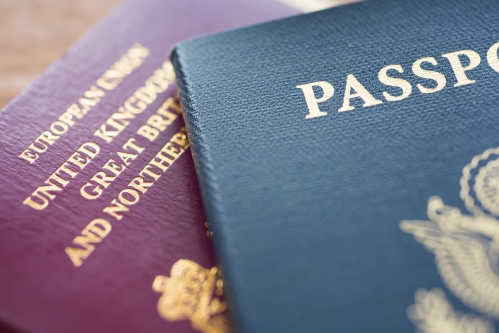
Today, friends, I bring you helpful tips on how NOT to plan a round-the-world sabbatical (or really any overseas trip). We are seven days out from our departure, and I am only just at this moment starting to feel somewhat calm about the to-do checklist that seems to become longer with every passing moment.
Let’s say – hypothetically, of course – that your little company’s primary client breaks up with you unexpectedly and you wait for your husband to come home from work and you petulantly say “Shall we just go traveling around the world in January for five months instead of the existing plans that we’ve been working on for years like proper grown-ups?” And he says yes because he’s thrilled to start traveling again even though he knows he’s always supposed to talk you out of your ridiculous ideas. And then you realize that you’re leaving IN EIGHT WEEKS and little things like visas and immunizations and closing up your house and your businesses and property taxes and mobile phone service and every other tiny adult detail starts to weigh rather heavily. So my first tip is to give yourself plenty of time to plan your trip. It takes longer than you think.
While talking with friends and family about our upcoming travel, I realized again and again that many people in this country simply aren’t aware of the requirements for traveling abroad. This may be because many Americans don’t travel internationally, or if they do, it’s as part of an organized package tour or cruise trip. And in those cases, a lot of the details are taken care of for you. If you’re an American citizen and you decide that you want to travel to a country other than Canada or Mexico, you need a valid passport. (In 2012, only about one-third of us had a passport – but that was apparently more than double the number in 2000. In comparison, some statistics show that over 80% of U.K. citizens have a passport.)
It’s also imperative that you find out that country’s visa requirements before you go, and the best place to do that is here. You will learn quickly that the requirements vary from country to country, and the amount of time you want to stay plays a big role too. Many countries (including most of western Europe, where Americans do frequently travel) have visa waiver programs with the U.S., and others offer electronic travel authorizations that can be easily obtained online. In certain cases, though, you need to send off your passport to an embassy or consulate so an adhesive visa can be attached. While many of the countries we’re visiting on our sabbatical don’t have visa requirements that apply to us, applying for our Indian visas has been one of the biggest challenges in planning this trip in a short timeframe. We did seriously discuss our options if our passports weren’t returned in time for our flight to Tokyo; thankfully, both passports are now safely back in our possession.
Our situation is also further complicated by the fact that I travel on a U.S. passport and N travels on a U.K. passport, so we had to handle each separately. You can learn a lot about geopolitical history simply by researching visa requirements. To wit: my Indian visa is valid for ten years and multiple entries, while N’s is single-entry and only good for six months. On the contrary, he doesn’t even need a visa to visit Vietnam for fewer than fifteen days, while I had to send my passport off again. Complex and intricate governmental relationships have a lot to do with the ease (or difficulty) of international travel for ordinary citizens.
The point is, start your research early. There are a lot of companies out there that will offer to apply for visas for you; this always comes with higher costs and some may not even be legal. If you want to travel overseas, know the country’s entry and exit requirements well in advance of your trip. “I didn’t know” or “…but I’m American!” are not valid excuses at any international border crossing.
And while we’re discussing starting your research early, you also need to know about any necessary immunizations. These might be required by the country for entry, or they might just be sensible to keep you healthy while traveling. Again, don’t wait until the last minute – certain immunizations might be a series of shots taken at timed intervals, and others only take effect after a period of time. Online resources now make this research so easy that I truly have no idea how I planned all of my solo travel when I was in my early twenties and we didn’t have this magical thing known as the “interweb.” N and I have traveled enough that we only needed typhoid shots prior to this journey, so that process was reasonably simple.
So! Visas, immunizations and now for a little on staying healthy while traveling. I’ll confess that at home, I’m not at all a fan of antibacterial everything, because I genuinely believe it damages our incredibly delicate and complex microbiome. That said, when I travel I am scrupulous about cleanliness – as much as I can be. I wash my hands whenever I can, use alcohol-based sanitizer and avoid ice in beverages.

I refuse, however, to travel scared. I eat street food whenever possible, travel on chicken buses and stay in local homes rather than antiseptic hotels. I can minimize risk, though, while still traveling with an open mind – hence the meal pouch above. Because I am mad crafty when I’m not cooking, I designed and sewed these travel squares as both a placemat and a cutlery holder. We’ll eat local food with our own (clean-ish) utensils, and we’ll have a reasonably hygienic eating surface that we can wipe clean and sanitize when no other option is available. These are primarily designed for our lengthy train trip in India, when vendors will hopefully offer snacks and drinks along the way. So much of staying healthy on the road is about paying attention: where are the locals eating? Is food that’s supposed to be hot actually served hot? Are there flies on the meat? I aim, as always, to be practical without being paranoid.
Clean tap water is something we take for granted most places here in the U.S. but is one of the primary causes of travelers’ maladies overseas, so we’re also bringing a SteriPen. I’m adventurous but not stupid, and I’d love to make it through our five months without either of us getting dangerously sick – purifying all of our drinking water goes a long way towards that goal. A little tummy trouble is to be expected when traveling, but we’d certainly like to avoid anything major.
But wait – ignore the potential for cholera and dysentery! We haven’t even talked about all the diseases you can contract just from the mosquitoes! We’re bringing plenty of DEET-based repellent, and we’ll treat our clothes and our mosquito nets with permethrin before we depart New Zealand for southeast Asia. While I’m not enthusiastic about poisons as strong as DEET, I’d gargle with the stuff if it kept me from getting dengue fever. I’d think differently if I were traveling with small children, the very elderly, or anyone with a compromised immune system, but for two healthy adults I firmly believe that the benefits of heavy-duty mosquito repellent outweigh the risks, especially when journeying through Third World tropics.
After all this scary stuff, the message I want to leave you with is this: if you’re thinking about traveling anywhere outside the U.S., just go. The above isn’t designed to terrify you, just to remind you to be sensible and to do your research before your trip. So many Americans don’t travel for so many reasons and while I know we have amazing things to see and do in this beautiful country, I believe that we also have to get out in order to appreciate just how good things are here. So go. Wherever you’ve always wanted to travel, go. You can make it work, whether it’s about finances, or time off, or just plain fear. I promise you, travel will change your life for the better – and you’ll value what we have here even more. Just go.

Elizabeth, you are a truly gifted writer and I hope you plan on writing a book following your travel adventures! 🙂
LikeLike
Kristen, thanks so much for your kind words. I hope our adventures will be entertaining enough for a book!
LikeLike
Pingback: Your helpful onsen etiquette guide | Finding Quiet Farm
Pingback: How to campervan in New Zealand | Finding Quiet Farm
Pingback: The FAQ Series: Eggs | Finding Quiet Farm
Agreed! Travel without fear, but not foolishly fearless, if that makes any sense. We are currently slogging our way through a multi-part blog series (https://wemarriedadventure.com) detailing how we are planning our trip around the world. I’ve been doing that for over a year, like it was a second job. Can’t wait to read how you guys pulled it off at the last minute!
LikeLike
Hi Mike! Thanks for reading! We’re thinking pretty seriously about getting back on the road again – and reading blogs like yours definitely inspires me! Hope you’re traveling well, and please keep in touch.
LikeLiked by 1 person